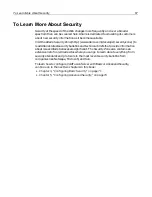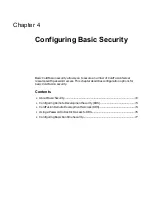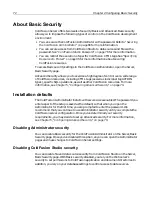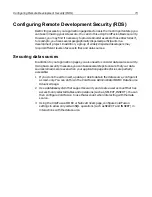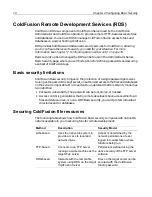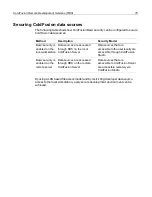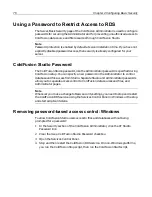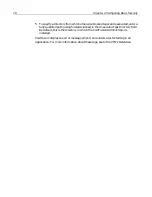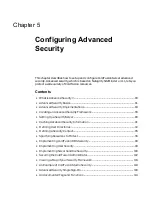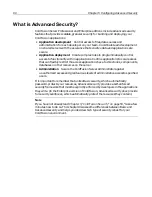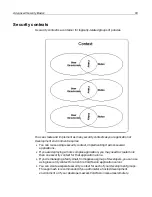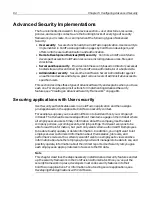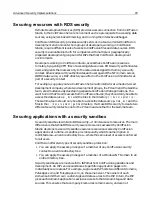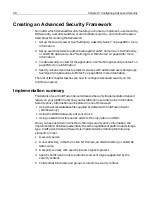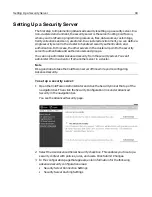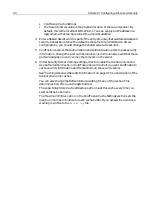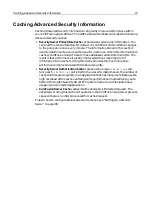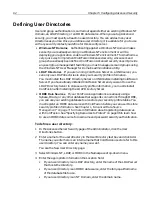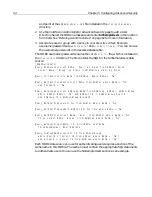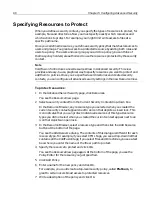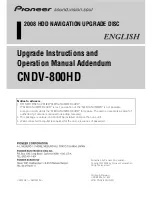
Advanced Security Basics
81
Advanced Security Basics
All types of Advanced Security implement the following four elements:
•
User directories
•
Resources
•
Policies
•
Security contexts
This section introduces these elements and describes how they work together to
build your Advanced Security framework. For detailed, hands-on instructions for
actually implementing an Advanced Security framework, see “Creating an Advanced
Security Framework” on page 88.
User directories
User directories provide a listing of user information, such as the user’s name, login
password, and the names of any groups to which the user belongs. ColdFusion
Advanced Security lets you incorporate any of the following industry-standard user
directories:
•
Lightweight Directory Access Protocol (LDAP) directory
•
Windows NT domain
•
ODBC data source
A user directory authenticates users by verifying that their credentials match those in
the directory. It tells you if someone is a valid user of the system. When you create a
security context, you select users and groups from a user directory and then
individually assign them access rights to ColdFusion resources. ColdFusion
developers then include code in their applications that checks if a user has rights to a
resource.
Because ColdFusion uses your existing LDAP directories, NT domains, or data
sources, you don’t have to create and maintain redundant user directories just to
develop or deploy ColdFusion applications. Using existing NT or LDAP provides an
added bonus: User groups to whom you assign security privileges automatically
inherit changes to group membership; no additional maintenance is required. For
example, suppose your company’s NT Domain contains a user group called BigDev.
You’ve used Advanced Security to give the BigDev group access to a number of
custom tags. Your company hires a new developer to work in the BigDev group.
When the new developer is added to the BigDev group in your company’s NT
domain, she’s automatically granted access to the custom tags because of her user
group affiliation.
Summary of Contents for COLDFUSION 5-ADVANCED ADMINISTRATION
Page 1: ...Macromedia Incorporated Advanced ColdFusion Administration ColdFusion 5...
Page 20: ......
Page 56: ...38 Chapter 1 Advanced Data Source Management...
Page 74: ...56 Chapter 2 Administrator Tools...
Page 76: ......
Page 86: ...68 Chapter 3 ColdFusion Security...
Page 87: ...To Learn More About Security 69...
Page 88: ...70 Chapter 3 ColdFusion Security...
Page 130: ...112 Chapter 5 Configuring Advanced Security...
Page 132: ......
Page 154: ...136 Chapter 6 Configuring Verity K2 Server...
Page 162: ...144 Chapter 7 Indexing XML Documents...
Page 202: ...184 Chapter 8 Verity Spider...
Page 236: ...218 Chapter 10 Verity Troubleshooting Utilities...
Page 238: ......
Page 348: ...330 Chapter 14 ClusterCATS Utilities...
Page 349: ...Using sniff 331...
Page 350: ...332 Chapter 14 ClusterCATS Utilities...
Page 362: ...344 Chapter 15 Optimizing ClusterCATS...
Page 372: ...354 Index...

